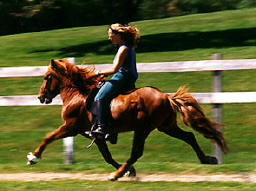Icelandic Horse
Also
Known By:
Islenzki hesturinn, Icelandic toelter horse, Iceland Tolter

Icelandic Horses are bred as 5-gaiters. They have the three basic gaits:
walk, trot and gallop, and the two extra gaits: tölt and pace, of which the
tölt is most popular. In tölt, the horse moves its legs in the same sequence
as in walk. Tölt is a very comfortable and pleasant gait that can reach a
high speed. Pace is a gait of speed and power in which both legs on each
side move together. Pace provides a very spectacular sight and a magnificent
experience in the saddle.
 |
|
 |
| Trot |
Canter |
 |
|
 |
| Tolt |
Pace |

 Horses
were brought to Iceland by the first Viking settlers, during the years 874 -
930. Their boats were small and only a few horses, the very best, were
brought along. At a very early stage, import of farm animals was forbidden
in the country, and the original Nordic horse was preserved purebred in
Iceland through the centuries. Horses
were brought to Iceland by the first Viking settlers, during the years 874 -
930. Their boats were small and only a few horses, the very best, were
brought along. At a very early stage, import of farm animals was forbidden
in the country, and the original Nordic horse was preserved purebred in
Iceland through the centuries.

To the Icelanders the horse was indispensable. The country was rough and
transport without Icelandic Horses was unthinkable. The Icelandic Horse
carried the inhabitants over wide lavafields and rough mountain tracks, and
acted as their bridge over powerful glacier rivers. Travellers counted on
its sense of direction and stamina. The Icelandic Horse was a part of life,
being a hard worker and a good friend. A good riding horse was a symbol of
dignity and a studhorse could be a much appreciated gift. Young and old,
rich and poor enjoyed the talents of the Icelandic riding horses and no
other people depended on the feet of their horses as the Icelanders did.

 The
Icelandic Horse has completed its task as the most needed servant, but has
taken on another, no less important task. In our technological age, people
turn to nature to relax from the speed and stress of city life. Man searches
for his origins and the Icelandic Horse has proved to be man's best
companion in this quest. Horsemanship combines healthy outdoor activity with
the sport and art of riding and the number of people who enjoy life on
horseback, in good company, increases steadily. The riders sense the nature
of their Icelandic Horses: their temperament, power, suppleness and pleasant
character, and they identify with those qualities. The
Icelandic Horse has completed its task as the most needed servant, but has
taken on another, no less important task. In our technological age, people
turn to nature to relax from the speed and stress of city life. Man searches
for his origins and the Icelandic Horse has proved to be man's best
companion in this quest. Horsemanship combines healthy outdoor activity with
the sport and art of riding and the number of people who enjoy life on
horseback, in good company, increases steadily. The riders sense the nature
of their Icelandic Horses: their temperament, power, suppleness and pleasant
character, and they identify with those qualities.

The Icelandic Horse has lived and developed in Iceland for over a thousand
years. Iceland's nature, sometimes harsh due to vulcanic eruptions and other
natural disasters, often took its toll of the horse population. Only the
fittest individuals survived. That is why the Icelandic Horse is very
healthy and tough. It is strong and surefooted, has a great temperament and
stamina and a very good character. The training usually starts at 4 or 5
years of age and the horse is fully adult at 7 years. Icelandic Horses reach
a very high age and can usually be ridden until they are well over 20 years
old.
 |
|
 |
| The Icelandic Horse in its
summer coat |
The same Icelandic Horse in its
winter coat
|

Today there are some 73,000 horses in Iceland and they are bred towards a
well described goal. Judges and breeding specialists judge the mares and
stallions according to strict rules. Judgement is based on the riding
qualities of the Icelandic Horses, as well as a healthy and beautiful built.
The goal is to improve these qualities steadily. The great interest in
organized horse breeding in Iceland is reflected in the presence of many
breeding societies and studs, as well as a stallion depot run by the State.
The Agricultural Society of Iceland supervises all horsebreeding matters and
keeps a studbook of all studhorses accepted by the jury.
 Diseases
are almost unknown among Icelandic horses. Protection of the horses is assured
by the strict regulations of the Icelandic government. No horse which has been
taken out of Iceland can come back into the country. Also only new, unused horse
equipment may be taken to Iceland. This is to prevent an outbreak of disease
which could decimate the population of Icelandic horses. Diseases
are almost unknown among Icelandic horses. Protection of the horses is assured
by the strict regulations of the Icelandic government. No horse which has been
taken out of Iceland can come back into the country. Also only new, unused horse
equipment may be taken to Iceland. This is to prevent an outbreak of disease
which could decimate the population of Icelandic horses.
Because Iceland has no predators, but instead is a country
with tremendous environmental danger, such as quicksand, rock slides, rivers
with changing currents, the ability to assess a situation rather than the
instinct to flee, have been central in the survival of the horse. Therefore,
these horses lack the “spookiness” that characterizes most horses. Due perhaps
to their lack of fear of living things, they seek strong attachments to people
and are quite nurturing and affectionate.
|